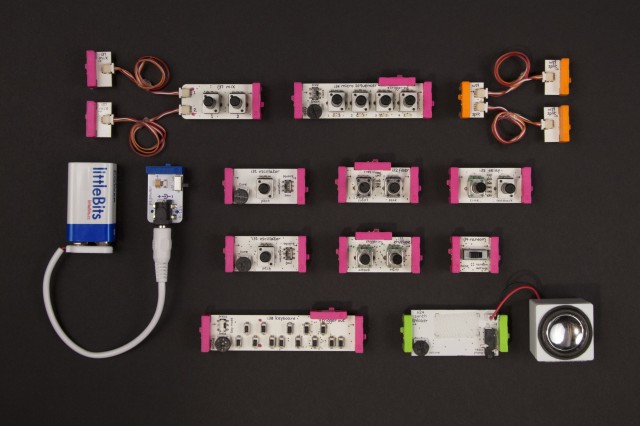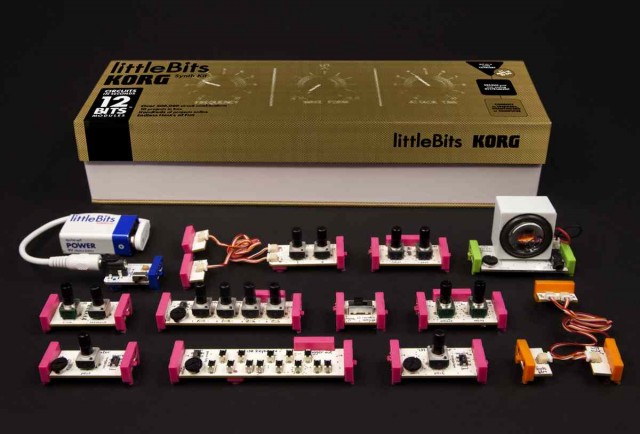littleBits, maker of an open source library of electronic Bits modules that snap together with magnets, has officially announced its partnership with Korg to launch the new littleBits Synth Kit.
The new Synth Kit includes an assortment of 12 electronic Bits modules that snap together with magnets to create circuits like those used in KORG’s analog synthesizers. Modules included in the Synth Kit are power, oscillator (x2), filter, envelope, delay, keyboard, micro sequencer, mix, split, random, and synth speaker (which can connect to recording or live sound equipment).
 “We’re excited to work together with industry leader KORG to design and launch the new littleBits Synth Kit,” said littleBits CEO Ayah Bdeir, right. “Our goal is to break technology down to its fundamental parts and put the power of electronics in the hands of everyone.”
“We’re excited to work together with industry leader KORG to design and launch the new littleBits Synth Kit,” said littleBits CEO Ayah Bdeir, right. “Our goal is to break technology down to its fundamental parts and put the power of electronics in the hands of everyone.”
The Synth Kit also includes a project booklet outlining step-by-step instructions for 10 projects. Accessories like mounting boards can be purchased separately to create a playable performance station.
And since the littleBits system is expandable, multiple Synth Kits can be used at once to create larger instruments. Users can also combine it with other littleBits modules to create complex visual, light, and mechanical installations, without wiring, soldering or programming.
Here’s a video demo of the Synth Kit in action:
The littleBits Korg Synth Kit

There are Twelve Bits modules:
- One blue power module.
- Nine pink input modules. The input modules are categorized as signal generators (Oscillators create sweeping tones), controllers (the keyboard produces voltages that create pitches), modifiers (the filter altera a sounds timbre), and modulators (random produces random voltages for sound control).
- two oscillator modules
- one random module
- one keyboard module
- one micro sequencer module
- one envelope module
- one filter module (based on Korg’s MS-20 synthesizer design)
- one delay module
- one mix module.
- One orange wire module: the split module. Use this to send one signal to two different modules like using a keyboard to control two oscillators.
- One green output module: the synth speaker module. This module amplifies the volume of your sonic creations and has an audio jack that can connect to recording or live sound equipment.
- Open-Source designs give access to circuitry in order to enable iteration and creation of new designs.
Accessories:
- One 9-volt battery and cable.
- Optional mounting boards can be purchased to create a performance station.
Project Booklet:
- Information on the included Bits modules and step-by-step instructions on creating circuits; 36 pages.
- Educational information on the science of sound and the history of the synthesizer.
- Ten projects with step-by step projects: Tuning, Play a Song, Spooky Sounds, Percussion Party, Metal Music, Synth Band, Synthesizer with the Works, Perform Like a Pro, Keytar and Synth Spin Table.
- Supplemental information on creating sound-altering circuits, such as: pitch sweeps, white noise, key player, sequencer control, frequency modulation, shape your sounds, random voltage, filtering noise and echo and delay.
The new Synth Kits will be shipping the first week of December and available at littleBits.com and select specialty retailers for $159.





The Vimeo video is asking me for a password to play.
Me too.
Should be good now.
Noisee!
Once again Korg slays Roland
Awww… who cares? Does anyone even think Roland would be competitive in this new ‘affordable analog’ market Korg is dominating, based on their output for the last 20 years? They’ve long-since lost any of the credibility they (justifiably) once had in the ’80s.
Could I have my Volcas please??!!
yeah, can’t wait to get Volca Beats, taking for ever here in Canada. Little Bit’s is looking good too.
I’m getting one for Christmas!
I love that the marketing is taking the piss out of the “master” wankery that’s too prevalent in the modular community.
This is great. I hope they come out with the monotron duo’s oscillators and the volca keys. I’ll build my own updated mono/poly!
Its open source and modular, you can build your own mono/poly…sorta.
this is the silliest promo vid i have ever seen.
I guess you haven´t seen the Keytar vid on their site then
Is this analog or digital?
They’re simple analog modules. The big showstopper is the wonky proprietary connectors which will make it a little hard to integrate your own DIY modules or connect an Arduino (which is something that will be done 50 times within the first few days, I suspect).
There should be a littleBits breakout board that brings the signal traces to a nice DIY-friendly header.
It’s a little unfair to use Reggie Watts in your promo video since he can make awesomenss out of thin air.
Idk…could also be from thick hair.
Well, one thing is certain, he’s clearly writing his own material in this video. Was it supposed to not be funny? His antics were as flat as this thing’s tone.
littleBits makes open source hardware, so those connectors are not proprietary (i still agree that they’re wonky though).
Its a magnate, if you wanted to make a connector you could essentially use one off a macbook theoretically. You can get those connectors for like a dollar, should work just fine to play with an arduino.
Why not make one?
I’m guessing there will be some entrepreneurs that will put out compatible modules. They seem to be encouraging this.
Those TINY keys looks more annoying than anything before.
Someone with a 3d printer should add some actual keys.
I hear that Scott Aukerman is shooting a promo video for a new Roland synth that combines velcro and FM for under $75.
Now i’m glad i havn’t started a eurorack yet. If these kind of products are an insight into the near future those eurorakers will be spitting chunks when 14 year old kids can make a bigger noise than them for a fraction of the cost.